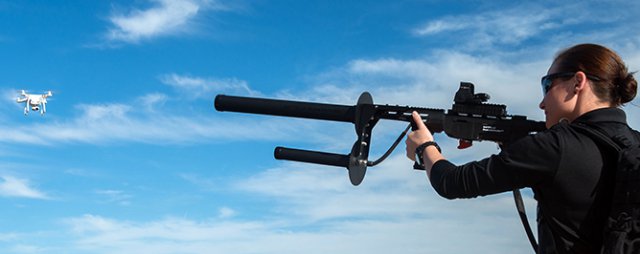 Battelle has updated and booked US government orders for its DroneDefender system designed to stop unmanned aerial systems (UAS) that could threaten civilian or military aircraft.
Battelle has updated and booked US government orders for its DroneDefender system designed to stop unmanned aerial systems (UAS) that could threaten civilian or military aircraft.
To date, the departments of defence and homeland security have ordered nearly 100 DroneDefender systems, a Battelle spokesperson told IHS Jane’s on 3 May during Association for Unmanned Vehicle Systems International’s (AUVSI’s) annual Xponential conference in New Orleans, Louisiana.
The point-and-shoot system utilises “a non-kinetic solution to defend airspace up to 400 m against UAS” such as the sort of quadcopter or hexacopter systems that are becoming popular with remote-control aircraft enthusiasts. Those small UAS can endanger civilian or military aircraft, but it is not feasible to shoot those UAS down because of collateral damage risks.
DroneDefender is configured like a rifle with antennas on its end, and on the latest version the antennas have been upgraded to provide a more directed signal, Haskell Jac Fought, a research leader at Battelle, told IHS Jane’s at the conference.

It can, almost instantly, disrupt a UAS’ radio control frequency or GPS guidance, seeking to stop the aircraft in mid-air and force it to land. Users can chose which signal to disrupt, but when both are disrupted this will cause most UAS to default to an emergency landing, Fought said. This means the government can recover the platform and learn what sensors it carries or if it was maliciously or accidentally in the wrong airspace.
The DroneDefender is designed to be aimed and ‘shot’ like a rifle, but can be fixed with battery packs for enduring protection. It offers up to 5 hours of continuous operation and weighs less than 15 lb depending on the configuration, according to the company.
Photos: Batelle, IHS/Daniel Wasserbly
Source: IHS Jane’s 360

Some potential issues with this technology:
1) Can it disrupt the same signals on manned aircraft? If yes, will this cause any issues?
2) What happens if a drone’s default setting is to Return to Land when a GPS signal or communication link is lost? I still haven’t seen a compelling argument to show that the drone won’t simply go up to the preset altitude (for RTH / RTL) and then regain its signal once out of range of the DroneDefender. Maybe this could mean that the drone has now gone out of where it shouldn’t be, but not sure if the DroneDefender will have control over which path the drone takes to do so.